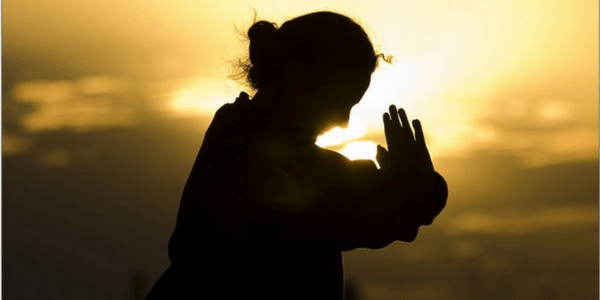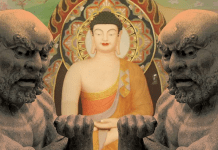
Meditation has become very popular in western culture in the last few decades, mostly thanks to spirituality and Buddhism becoming more acceptable in the mainstream. More and more people are becoming interested in the various benefits, but might not know that there are many types of meditation that give different benefits, and each has a different history. Here I will give a brief rundown of four beginner-friendly types of meditation, and give the history of each, as well as teach you how to get started on your own regiment. All of these methods serve different purposes and will suit different people, but one might find themselves practising each of them at different points throughout their spiritual practice.
Thought meditation
Also called awareness or mindfulness meditation, this variation of mediation started in Buddhism, specifically Zen practice. It became popular in the west as part of mindfulness practice, as a way to reduce suffering by being self-aware and living in your present moment. It’s a great meditation for beginners because it’s simple and forgiving, requires nothing but some alone time to start, and doesn’t require a huge time commitment. It is also known to reduce stress and anxiety significantly if done regularly.
- To begin, you’ll want to be wearing something comfortable that you can breathe easily in. Then, find a comfortable place to sit, either lotus style or with your feet on the ground. Just make sure your back will be straight and that you will be comfortable.
- Get yourself comfortable and relax yourself. Close your eyes if you wish. Start to notice the positioning of your arms and legs, and whether they are tense or relaxed. If you are tense, try to relax your limbs. Take a few deep breaths.
- As you get more relaxed, notice your breath. Are you breathing out of your nose or your mouth? Are you breathing shallow or deeply? Start to focus your thought towards your breath, without necessarily controlling it.
- Your mind will inevitably begin to wander as you do this, and when it does you want to just gently bring it back to your breath. If you feel your mind is wandering constantly, that’s fine, don’t get frustrated. Just notice your thoughts and continue to bring your attention back to your breath. It will get easier over time.
- Do this for as long as you please, or set a timer or alarm, and then slowly bring your attention away from your breath and come back to reality.
Awareness meditation should be practised every day, starting with small amounts of time (about five minutes) and gradually increasing until you get to around twenty minutes. No extra materials are required for this meditation, other than a space to practice in and time where you will be undisturbed. If you prefer to have a teacher, you can often find classes for guided meditations of mindfulness, but it is perfectly doable alone for most people.
Breathing meditation
The deep breathing and breath counting methods of meditation are related to the thought and mindfulness methods, and are only slightly harder for a beginner. According to the Anapanasati Sutta, this method was also developed by Buddhists around the 12th century. The benefits of breathing meditation are many, as monks used it to increase their concentration, and its purpose lies also in bringing the mind and body to a place of harmony and giving the practitioner a sense of inner peace.
- Make sure you are wearing comfortable clothes that you can breathe easily in. Sit either in a firm chair, or on the floor in the lotus position. Whichever way you are sitting, make sure that your back is straight. If you are in a chair, place your feet flat on the floor parallel with each other and equal with your shoulders.
- Close your eyes, relax your body, and focus on your breath. When you are ready, slowly inhale through your nose and let your belly fill as you do. Once your belly is close to full, pause for about three seconds before exhaling your breath through your nose and letting your belly deflate. Count this breath as “one”.
- Continue breathing in this manner and counting each full inhale and exhale all the way up to ten. Then, count back down to one.
- If your mind wanders at all, that is fine, just bring it back to your breathing and counting the breaths. If you forgot where you were in counting, restart at “one”. The goal is to go from one, to ten, and back to one without making any mistakes, and then gradually increase that number to twenty, forty, etc. It is like a mental exercise. When you finish, gently bring yourself back to reality.
Breathing meditation should be practised every day to achieve better results. The main difficulty in using this method is the time dedication, as early on you may make a lot of mistakes and have to restart the counting a lot. However the benefits of mental clarity and increased concentration are great, and very worth the effort if it is possible for you.
Related: Connected breathwork and subtle energy, by David Lee
Energy meditation
This method of meditation stemmed from the western esoteric tradition as a way to increase positive energy in one’s aura. It was likely based off of chakra focus practices from the east and modified from there. This type of meditation is great for increasing your overall positive energy and preparing yourself for the day. It also increases your powers of visualization.
- Get in any comfortable position you would like. You can even lie down, just make sure that you won’t fall asleep during your meditation. Some might find it useful to focus on some sort of crystal, such as clear quartz or amethyst, to increase their psychic energy.
- Breathe in slowly, and as you do, imagine a brilliant white light entering you from all sides. As you become more experienced, you may experiment with visualizing different-coloured auras.
- When you exhale, imagine the white aura expanding.
- As you continue to breathe in, imagine the white light becoming more and more bright and powerful.
- You may either set a time for yourself, or go until you feel you are bursting with energy, and then slowly come back to reality with the knowledge that you now have this powerful aura at your disposal.
Energy meditation can be practices whenever you want to change your aura, or to increase your inner connection with your own aura. This could mean daily practice, or less frequently as you need it. You can use other magical items, such as crystals or incense, to increase the effectiveness of this practice, but it will work just fine by itself.
Invocation meditation
Invocation is steeped in the practices of kabbalists, hermeticists, and other ritual magicians. Calling on one’s chosen deity can be a very important part of meditation as well. This practice likely stems from Buddhist deity yoga, where one visualizes mandalas associated with their chosen deity with the goal of reaching divinity. With invocation meditation, one’s goal is to ask the deity for assistance in bettering themselves, and to eventually become one with their own internal divinity.
- Get in comfortable clothing and sit somewhere, preferably in the lotus position. You will want to surround yourself with things associated with your chosen deity, such as incense, herbs, colors, rocks, statues of said deity, etc. You can do the meditation without these things, but it is more effective if you have them.
- Begin your meditation by relaxing yourself and focusing on your breath. Try to breathe deeper than you normally would. Do this for as long as you need to achieve a completely relaxed state. The closer you can get to a trance, the better.
- Either out loud or internally, speak (or vibrate) the name of your chosen deity. Do this slowly and speak it as you exhale. Focus strongly on the name as you speak it, and enunciate it distinctly. Put meaning into the name as you speak it. Continue doing this for a minute or two.
- Speak a mantra or prayer of your intention to your deity. Before you begin your meditation, think of why you want to invoke this deity. If you are invoking Athena, is it because you desire wisdom, or do you desire power? What way do you want to use it? You can find some prayers and mantras online, but I find it’s more useful to come up with your own. You’ll generally want to open the prayer with praises to the deity, and then state your request, and then close the prayer by giving them thanks.
- After this, you will want to slowly come out of your trance state and back to reality. Take your time with this part, and don’t come back until you feel you are ready. You don’t want to be back in reality until you are mentally prepared, otherwise you may stay in a pseudo-trance for longer than you intended.
This method of meditation should be used sparingly, unless you want to incorporate it into a devotional practice, in which case you can do it every few days or even daily, but only if you are experienced with this deity. Otherwise, only invoke a deity if you are specifically asking for assistance, and use this only when needed. This method can be very exhausting, and you don’t want to anger a deity by accident.
Conclusion
As meditation becomes more widely accepted and practised, you may want to try it yourself. I would definitely recommend thought or breathing meditation to begin, as their benefits are great and it takes very little to get started. Once you get more comfortable in your practice, consider researching other types of meditation (There are many more than what I have listed here) to add to your daily spiritual practice. There’s no bad way to meditate, and you will only get better as you practice. So start soon and practice every day! It can only benefit you.
Image credit: Tarcio Saraiva








